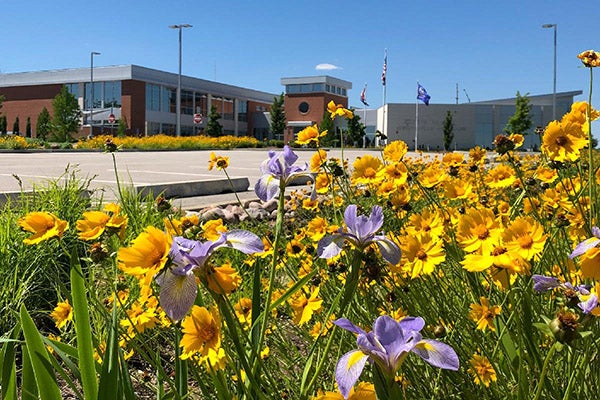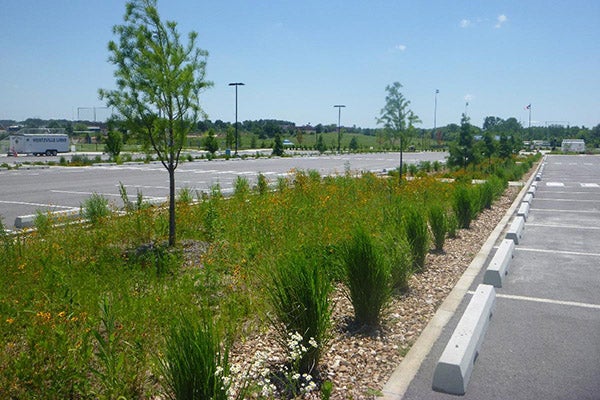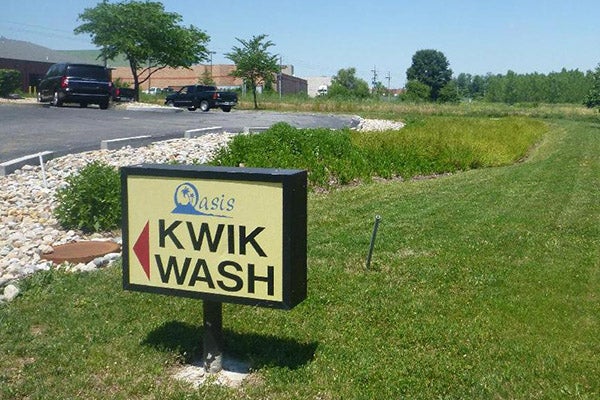Landscapes For Rain
Get inspired on your own property or common grounds! Here are highlights from a variety of green infrastructure projects around Wentzville that make use of important water resources and even help resolve nuisances and maintenance issues.

Traditional stormwater management drained water away as quickly as possible. Unfortunately, this increase in volume and flow led to two key effects: flooding and stream erosion (ARC 2010). This can be reversed with green infrastructure to benefit our community’s health and vitality.
Uniting Built and Natural Environments
Modern approaches aim to rebuild the natural water cycle: soak it in, recharge groundwater and store runoff water for a certain time. Collected water can even be used for irrigation or household supply. Innovative practices, called green infrastructure, include rain gardens (e.g. bioretention basins), infiltration basins, grass swale filters and retention basins.
Recent projects have been implemented to creatively handle runoff, improve water quality and lessen stream impacts. They offer residents and businesses learning opportunities as well as shine a light on the future of stormwater management.
What is Green Infrastructure?
Green infrastructure: using the landscape (vegetation, soils, and natural processes) as infrastructure to manage water and provide a range of ecosystem services — clean air and water, flood protection and wildlife habitat. This approach to stormwater management mimics nature by soaking up and storing water.
Green infrastructure is effective, economical, and enhances community safety and quality of life. It means planting trees and restoring wetlands, rather than constructing more pipes and expensive treatment systems.

Wentzville City Hall
Did you know that these plants and underlying soil are filters that help keep our waterways clean?
City Hall’s design showcases nine native plant-filled rain gardens, which are also called bioretention basins. The basins not only look gorgeous but also capture and clean parking lot runoff before it drains into Crossroads Creek. They provide habitat and food benefits for wildlife, too. A sand filter is also used with sand and gravel layers to trap pollutants like trash, sediment, dissolved metals and even bacteria. Collectively, the basins are treating 22,800 cubic feet of stormwater before it leaves the site.
Heartland Park
Heartland Park uses green infrastructure to help filter stormwater runoff before it reaches the seven-acre lake. The lake and green infrastructure located in the park serves as flood control for 472 acres of drainage area. With 2,500 trees, shrubs, and flowers, these biofilters serve as an innovative way to improve water quality.


Demonstration Project: Oasis Kwik Carwash
Oasis Kwik Carwash had a traditional-style detention basin that often filled with litter and debris. This blocked the storm drain, preventing proper drainage and causing stagnant water that attracted mosquitoes and other unwanted pests. A bioretention area was added which uses plants and soil to improve drainage while also filtering pollution.
Demonstration Project: Huntsdale Subdivision Basin
Over the last decade, construction caused a build-up of silt which filled in the basin that was originally 9-foot deep. Higher water temperatures and nutrients from geese and lawn fertilizers in runoff lowered the oxygen, caused excessive algae and killed fish.
Retrofit Project Goals: Remove silt and trash, increase oxygen for aquatic life, and create rain gardens, or biofilters, upstream using native plants and soil to soak in and filter runoff and remove pollutants before it gets the basin and Spring Creek.
Monarch Butterfly Habitat
Monarchs are important and beautiful pollinators for plants. Populations have declined 90% due to habitat loss and environmental stress. The Midwest is a vital breeding ground for monarch butterflies traveling to Mexico and we play a critical role in their success or decline. Learn how you can make a difference by planting native milkweed and other plants for habitat.
Native Plants & Tips for Your Yard
The source of our drinking water (local rivers) starts at your front door. Your yard can have a big impact on the quality of our local waterways. By keeping litter, chemicals and yard waste out of street gutters and storm drains, you are helping prevent stormwater pollution – since these drain directly into nearby lakes, streams or wetlands without being treated or filtered. Remember: only rain should go down storm drains.
References
ARC (Editor) (2010): The Countryside Living Toolbox: A Guide for the Management of Stormwater Discharges in Countryside Living Areas in the Auckland Region. Auckland: Auckland Regional Council (ARC). URL [Accessed: 07.03.2012]. PDF


